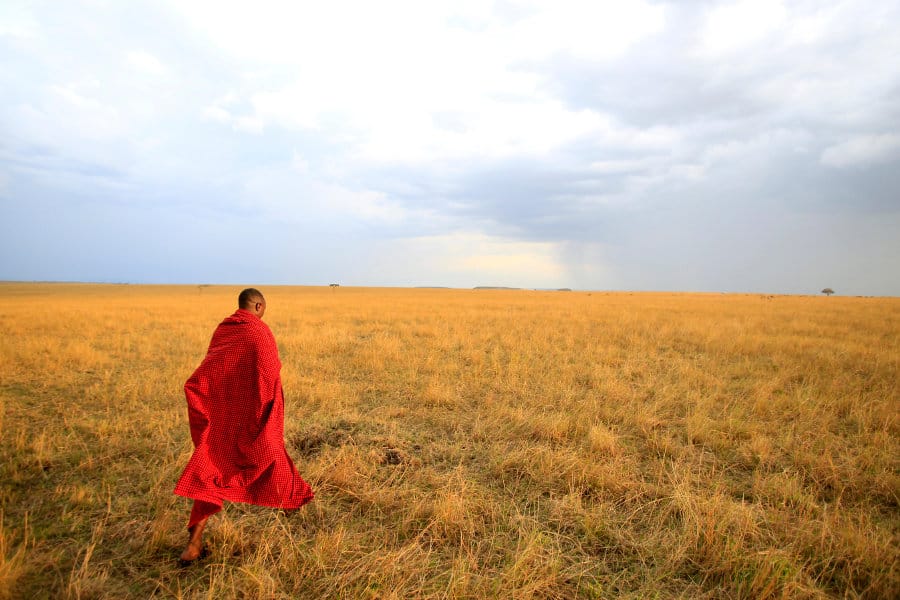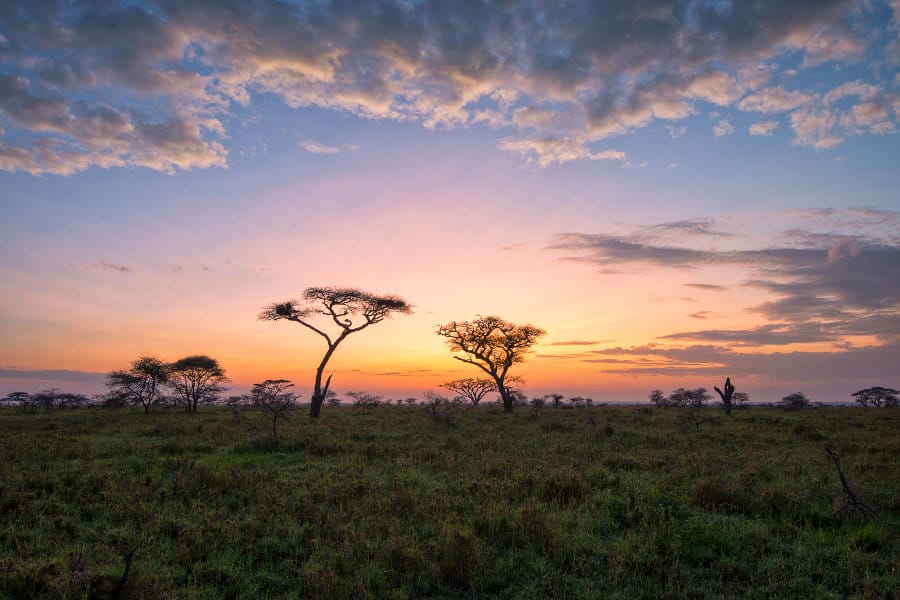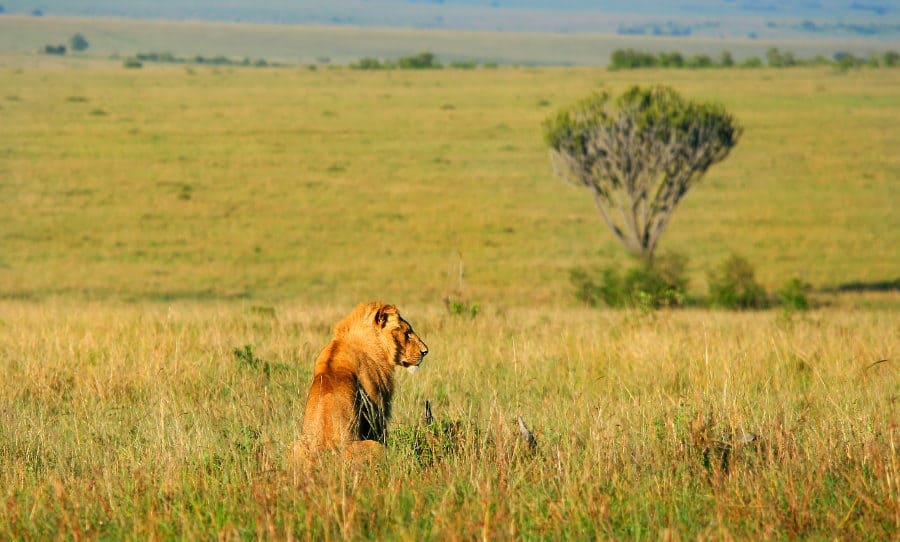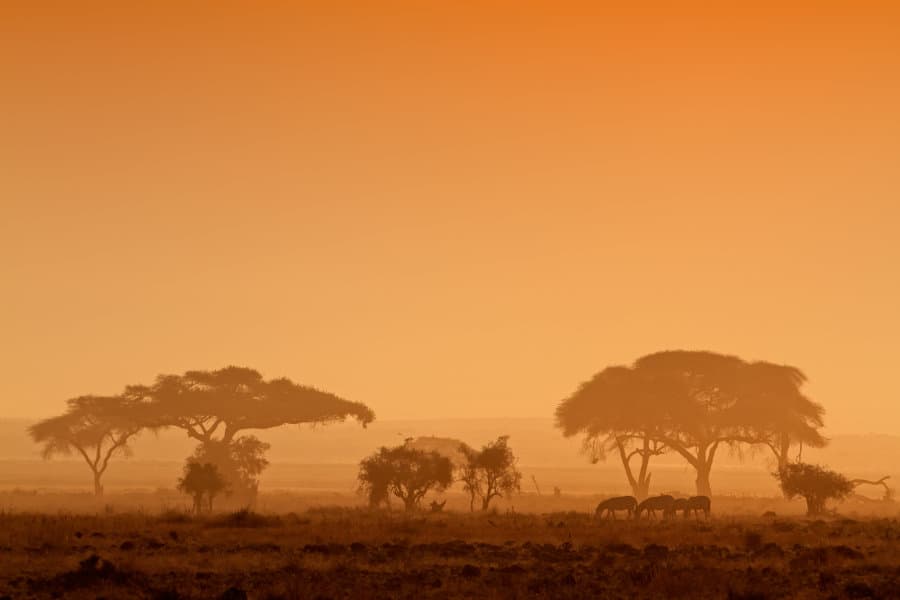The African savanna is an almost mystical place, where lions roam and elephants bulldoze paths through the trees.
It can be magical, especially if you are on safari with a good guide. But it can also be dangerous.
Survival in the African savanna requires basic knowledge of the environment, weather, and wildlife. Lack of water and heat are likely to be your biggest threats to overcome.
Locate safe water, find some food to snack on and understand the wildlife dangers, and you will survive!
Most trips to the African savanna are guided tours with an experienced local guide to inform, lead, and protect visitors to the continent.
This scenario is great when things go according to plan, but what if you find yourself without a guide in the vast savanna?
Will you survive?
This article shows you some basic tips for surviving on the grassy plains, including finding water and edible plants.
Can You Survive the African Savanna?

Africa is beautiful, exotic, and diverse, but it can also be dangerous!
Most travelers to the vast open spaces of Africa are accompanied by a knowledgeable guide. The guide’s job is to explain the wonders of the African bush, plus keep you safe at all times.
Many visitors to Africa are unaware of the potential dangers that the environment, fauna, and flora can pose to the unwary traveler.
We have a saying in Africa that denotes the type of outlook you need to have to survive this continent. “Africa is not for sissies” is a common phrase you will hear in this region of the world when the going gets tough.
Essentially this means that only the strong survive Africa. This saying holds true for the animals that roam here and the people that set foot on these shores!
While it is an unlikely event that you will be lost and alone out on the African savanna, there is always the possibility, especially if you travel without a guide.
What is the African savanna?
The African savanna describes the landscape and climate of certain natural biomes on the continent. Vast grassy plains and woodlands characterize the open space.
The plains of Africa can be fairly flat and featureless, which contributes to people losing their bearings and becoming lost.
One of the overwhelming feelings most people experience out on the savanna is how vast the continent is and how small they are in comparison.
This feeling can be a little intimidating to some but exhilarating to others.
The savanna landscape can be found all across the African continent, though the locations most travelers visit are east and southern Africa.
This spacious ecosystem can quickly lose its mystique and become very hostile if you are alone or stranded on the plains. Some basic survival skills can rescue you from a sticky situation if you find yourself stuck in the bush.
Surviving the environment of the African savanna
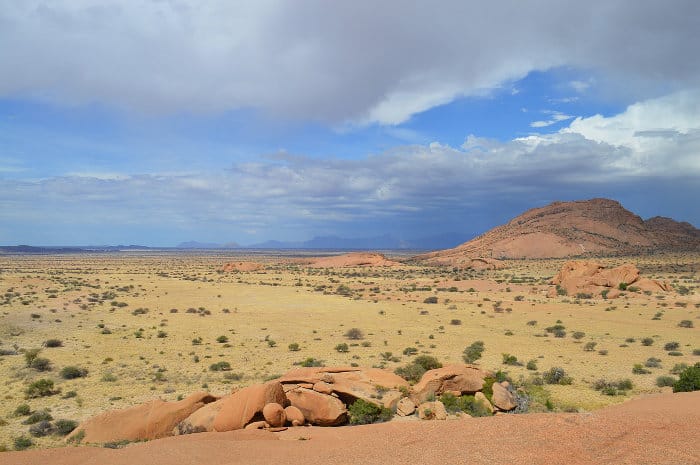
Most people think that the biggest danger to worry about in Africa is the wildlife, but this is not necessarily true.
The African environment on the savanna poses a more immediate threat to the survival of anyone stranded on the plains.
Africa is described as the hottest continent on Earth, with the average temperatures being higher than most other continents on the globe.
Daytime temperatures on the grasslands can become as high as 104°F (40°C) or higher, depending on the region of Africa you visit.
The high temperatures can cause the following dangerous issues for the reckless.
- Severe sunburn
- Heat stroke
- Dehydration
How do you avoid the harsh African sun becoming a problem? Do not walk or exert yourself during the hottest part of the day, typically between noon and 4 pm.
Seek shelter in the shade during this part of the day and wait for the temperatures to drop off before undertaking physical activity.
Protect yourself from sunburn by wearing light cotton long-sleeved shirts and trousers. Lighter colors will keep you cooler than dark colors.
Always take a hat when you go out on the savanna, preferably a hat with a brim all the way around rather than a baseball cap. A hat will protect your face, ears, and neck from sunburn.
Winter night-time temperatures can drop low enough to make you feel cold, so taking a light jacket with you during a daytime safari is a good clothing option.
You could be out later than expected on safari, or if your vehicle breaks down, you may be exposed to cooler evening temperatures.
Finding water on the African savanna
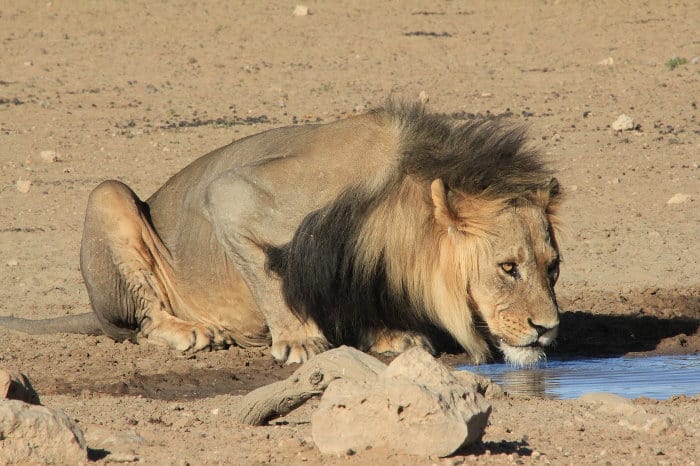
Dehydration is a serious threat out in the open if you are unexpectedly isolated. High daytime temperatures can cause you to lose body fluids rapidly and become dehydrated.
As a precaution, you should always travel with more drinking water than you think you need. There are a few useful strategies to find water in the savanna if you find yourself without water.
Rain is an infrequent event on the savanna, but if it rains while you are stranded, try to catch as much rainwater as possible with whatever containers you have at your disposal.
If there has been recent rain, rocky outcrops are a good place to find fresh water in shallow depressions on the rocks.
A smart strategy to look for water is to find some higher ground to get an elevated view of your surroundings.
This can be a large anthill, a small hill, or even the roof of your car. While in the elevated position, look for signs of civilization, such as roads, buildings, or smoke.
Scan the landscape for clumps of trees or a line of trees across the plains, which could indicate a watercourse.
If there is water in the stream or river, you can use it for drinking, but it would be better to boil it first. Always check for crocodiles and hippos in any body of water.
Animals use these water sources, so scan the banks for wildlife before approaching the water’s edge.
Animals move to and from water sources to drink in the savanna, so following animal trails heading downhill could lead to water.
Standing pools of water are usually unsafe to drink because of bacteria and parasite contamination.
Dig in the sand a little way from the water’s edge to access water filtered through the sand. This water should be clean enough to drink, but boiling it first would be the best option.
In dry river beds, look for the lowest points of the watercourse and dig into the sand in the river bed to find water.
A favorable location is the inside of any bends in the watercourse, where the water flows the slowest and has a chance to seep into the sandy river bed.
Once you feel the sand in the hole becoming moist, dig a little deeper and wait for the water to filter into the hole.
Can you use plants as a water source on the African savanna?

Plants can be a good source of water if you know where to look and which plants to use. But this option can be unsafe if you use the wrong plants.
Certain plants may seem like a nice option, but their juices can make you sick. The Bushmen, or San people, have used this method to find water in inhospitable environments for centuries.
They use a root from a certain Kalahari Desert plant called a “bi! bulb,” which stores water underground. The root is dug up and squeezed in your hand to extract the life-giving water.
Unfortunately, you need to know what to look for to tap into these resources. A more accessible plant source of water is the baobab tree, which is distinctive in shape on the African plains.
These trees capture rainwater in crevices in the tree’s crown and can be a valuable resource if you are desperate for water.
Finding food on the African savanna
Finding water often leads you to potential food sources when marooned in the African bush.
Many of the fruit-bearing trees and bushes grow near water sources.
Edible fruits and useful plants
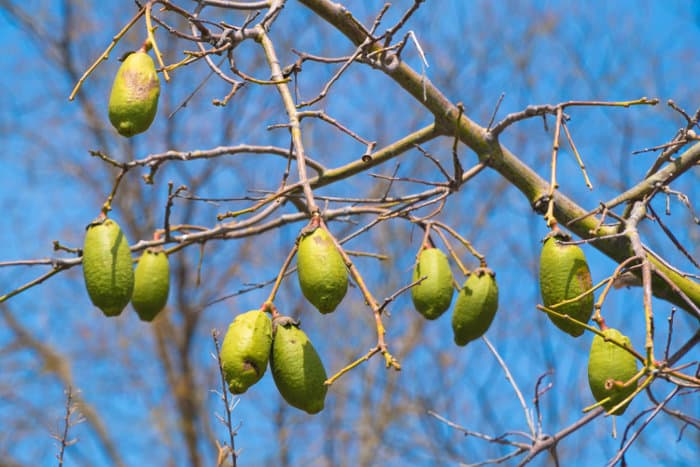
- Acacia tree. There are multiple acacia trees native to the African savanna. The young leaves, flowers, and seed pods are a good food source and can be consumed raw or cooked.
- Baobab tree. We have already mentioned the baobab as a water source, but it can also be a potential food source! The large fruit has a hard shell, which, when broken open, reveals whitish seeds inside.
The whitish, powdery flesh is high in vitamin C. There are hard, brown seeds in the center of the flesh which are too hard to break open.
- Horned melon. Also known as wild cucumber, this ground creeping plant has a fruit that looks like a short, spikey cucumber. The flesh is juicy and sweet, but the seeds of some species are toxic and should not be eaten.
- Magic guarri. The magic guarri is a shrub common in the South African grasslands. It bears black fruit that although edible aren’t very tasty. The bark can be used to cure headaches.
Fun fact: frayed twigs can double as a toothbrush. This is often done by chewing the end of the twig for a few minutes.
- Marula. The marula tree is a common species in the veld. The very tasty fruit is loved by humans and wildlife, especially elephants. The famous African Amarula liquor is made from the fruit of this tree.
- Monkey orange. The monkey orange tree is common in savanna woodlands. The fruit is about the same size as a normal orange but with a hard shell.
The shell is easily cracked, and the flesh is very juicy. The fruit is pale yellow when ripe, and it is only edible for humans at this stage.
- Raisin bush. Bushmen people use the branches to make bows, arrows and friction sticks to make fire. Raisin bush berries are edible, the leaves can be used for tea, whilst the bark is often utilized to make rope.
- Sycamore fig. The sycamore fig tree grows along water courses, so you may come across this tree while searching for water.
The marble-sized fruit is present on the tree for most of the year, making the tree a good potential food source.
- Wild melon. Known as “tsamma” in the Kalahari desert, it looks pretty much like the normal melon variety.
Wild melons could be a life saver when stuck in the middle of sandy savanna regions, due to their high water content. Both the seeds and skin can also be eaten when roasted.
NB: If you’ve just had a bitter tsamma, spit immediately, for those could be poisonous.
- Mother-in-law’s tongue. This succulent plant is another great option to (hopefully) never go thirsty again.
To extract the water, here’s what to do:
- Find a good stick.
- Dig around the “snake plant” without damaging it.
- Once you find the root, cut a section off with your stick.
- Scrape off the excess dirt with a knife or sharp stone.
- Ultimately, squeeze the watery substance with your teeth and enjoy.
Down it goes. Et voilà!
Sources of protein

While eating wild fruit and berries can keep you going for a while, a more substantial meat meal would give you more energy for survival in the savanna.
Several small animals, insects, and birds can be trapped and used as a protein source if you are abandoned in the bush.
While most insects can be eaten raw, any other protein source, such as rabbits, rodents, and other small game, should be cooked before being eaten.
Many of the snakes on the savanna are deadly venomous, so you should not try to capture them for a meal unless you can tell the difference between harmless and dangerous African snakes.
Surviving the wildlife of the African savanna
The wildlife that people come to see in Africa can pose a serious and sometimes unexpected threat to the unwary person stuck in the bush.
Sometimes these animals are a danger in campsites, even if you are not lost and alone.
On one occasion, we experienced a large African elephant bull that wandered into our campsite in the early morning and insisted on feeding on local trees.
The big bull elephant displayed aggressive behavior and would not allow guests to walk from the accommodation to the safari vehicles.
Needless to say, we had to delay our departure for the morning safari until the giant had eaten his fill and moved on.
Most animals on the savanna are more afraid of you than you are of them. The vast majority will get out of your way, but others may see you as a potential threat or a meal!
Are you a predator or prey on the African savanna?
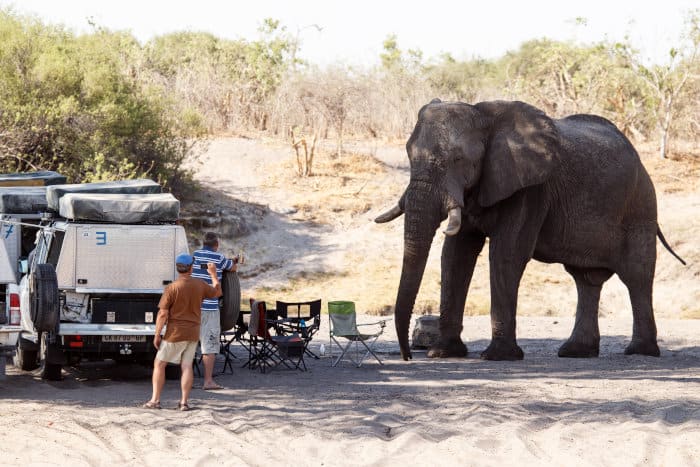
Most of the 3000 animal species on the African savanna see humans as apex predatory species and will prefer to flee rather than seek confrontation.
But these same animals will attack if they feel cornered, threatened, or have babies with them. Some savanna animals view humans as prey, and we will be on the menu if they get an opportunity.
Lions on the savanna
Lions are large predators but mostly view humans as superior predators. This perspective means they will avoid us when they can.
However, if you turn your back on a lion and run, their natural instinct to chase will be triggered, and they will chase you, catch you and eat you for dinner.
Stand your ground with lions, wave your arms in the air, and shout as loud as you can. This strategy makes you look bigger and more intimidating, and the lions may back off.
Leopards on the savanna
Leopards are solitary hunters and smaller than lions but extremely strong and dangerous.
They generally do not see people as food and will leave you alone unless they have cubs or feel threatened.
Never turn and run from a leopard, as this will provoke their chase response, and they will attack you. Slowly back away to give the animal space and reduce the threat, giving the leopard a chance to escape.
Elephants on the savanna
Elephants do not like people entering their personal space. They will charge if they feel threatened.
If you encounter an elephant, back off slowly and try to put a large object, such as a tree or boulder, between you and the pachyderm. Give an elephant herd a wide berth if you see them on the African savanna.
Following a herd of elephants from a distance is a way to find water on the open plains, as these imposing beasts need to drink daily.
Hippopotamus on the savanna
Hippos kill more people than crocodiles in Africa.
This is not because they want to eat us but because they feel threatened when humans come between them and their safe place, which is the water.
Hippos exit the water at night to feed on surrounding vegetation. While they do this, they can wander into campsites, or you may inadvertently walk between them and the water.
Hippos may attack in these situations because they feel vulnerable out of the river.
Crocodiles on the savanna
Every watercourse or body of water in Africa should be treated as if crocodiles are present, even if you cannot see any.
Crocodiles see humans as prey and will actively hunt any person they see on the edge of the river or in the water.
Surviving the creepy crawlies of the African savanna
The creepy crawlies of the savanna can be as intimidating and dangerous as the larger animals that we perceive as more of a threat.
Many African snakes are venomous and should be avoided as far as possible. Termite mounds, rocky outcrops, and thick grass are preferred habitats for these creatures, and many are masters at camouflage.
Watch where you put your hands when collecting firewood or where you step while walking through grassy areas.
Most African spiders are harmless to humans. A few harmful species occur, but you are unlikely to be accosted by them.
Scorpions are a danger at night, so do not walk barefoot. The risk of being stung by a scorpion is much higher after dark.
Let common sense prevail out on the African savanna
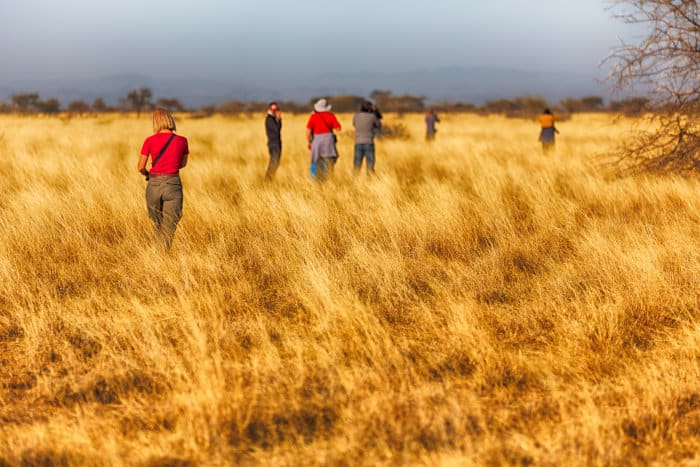
While some of these scenarios may paint a grim picture when you are lost or isolated on the African savanna, it is not as bad as it sounds.
Use your common sense, treat all wildlife as potential danger, and you will likely survive your adventure and have a thrilling story to tell your grandchildren!
Experience a Guided Savanna Safari
If you would like to experience a guided safari in the African savanna, where you will not have to put your survival skills to the test, take a look at our safari deals.
These tours are all conducted by professional guides with intimate knowledge of the African bush!
